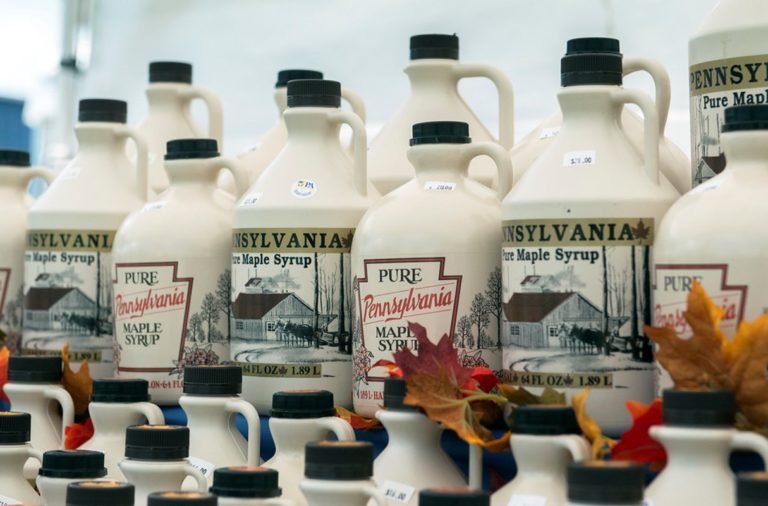
Profile
About
By supporting the maple producers of Potter and Tioga Counties, the Potter-Tioga Maple Producers Association celebrates the region’s sweetest natural resource!
The Potter-Tioga Maple Producers Association supports the many maple producers throughout Potter and Tioga Counties through a bulk supply ordering program, producer education opportunities, and promotional and educational events for the public, such as Maple Weekend each spring.
About the Annual Potter-Tioga Maple Weekend:
“The annual Maple Weekend began in 2005, and currently has 23 participating farms across Potter and Tioga Counties. The farms offer tours, demonstrations, and the finest in pure maple products, and visitors learn about the interesting story of each farm and the unique processes developed by individual producers.” Source PA Maple.
History of the Potter-Tioga Maple Producers Association
In the middle of the 20th Century, cane sugar began to overwhelmingly be used in the home and commercially, driving maple producers to begin processing harvested sap into syrup.
While technological advances such as sterile plastic tubing systems, vacuum pumps, louvered pans, and natural gas or oil-fired evaporators were streamlining the collection and production processes, maple products were being retailed to consumers by a few large corporations, mainly based in the northern US and Canada.
Only about 20% of the syrup produced on local farms was sold directly into the retail market. The rest had to be sold in bulk to dealers, who graded the syrup and paid by weight, typically at $.22 per pound to northern Pennsylvania producers, or up to $.26 per pound for “fancy” grade. The syrup was then shipped to cities in New England or New York by rail.
This phenomenon was replicated across the country, with small retailers shouldering the labor, land, facilities and risk; the large companies handled transportation and packaging, and reaped the bulk of the reward.
By the 1950’s, maple producers across the country realized that even with all the technology and increased efficiency, they would not be able to turn a profit without establishing a retail market.
In 1959, the National Maple Council was organized, and the first “Maple Digest” was published and distributed to every known maple producer across the country for free, with printing costs paid by advertisers.
“It certainly did a good job of letting us know there were a lot of other people with the same problems we had and what some were trying to do about them,” wrote PTMPA charter member Bob McConnell.
The Potter/Tioga Maple Producers Association (PTMPA) was organized in 1963 by eighteen maple producers living within the two counties.
Members were able to pool their money and buy syrup containers and other supplies in bulk, and invested those savings along with a $5 annual membership fee and a small markup on jugs in advertising and other initiatives.
PTMPA followed the lead of organizations across the country, hosting two wildly successful Maple Tours in 1966 and 1972 and beginning an annual Maple Festival in Coudersport which has turned into an end-of-summer tradition attended by thousands of people from across Pennsylvania and beyond.
The first Maple Festival was held in 1967, featuring a booth with delicious, locally-produced pure maple products, other vending areas, and the crowning of Maple Sweethearts chosen from young ladies from Potter and Tioga Counties.
A $200 donation kicked off the first event, with labor, products and the remainder of necessary funds kicked in by PTMPA. It took three years for the event to turn a profit, but it has continued to grow ever since thanks to the dedication of members and community members.
The event is held on Courthouse Square in historic downtown Coudersport, and features a lengthy parade, carnival rides, community events, local business promotions, and a number of educational and shopping booths, as well.
The annual Maple Weekend began in 2005, and in 2023 currently has 23 participating farms across Potter and Tioga Counties. The farms offer tours, demonstrations and the finest in pure maple products, and visitors learn about the interesting story of each farm and the unique processes developed by individual producers.
Some farms fire with natural gas or fuel oil, while others use a traditional wood fire during the evaporation process. While most farms have gone to tubing and vacuum-pump systems, a fair number still hang some buckets in the trees, and a few have foregone central collection all together.
Even the creation of products varies at each location and range from maple salad dressing or barbecue sauce to jellies and homemade cookies to maple milkshakes or cotton candy. Each farm has a specialty and a recipe or two that have been passed down through the family over generations.
Producers in the PTMPA have seen the benefits of organization. Pooling resources has allowed them to print full-color brochures complete with maps, directions and GPS coordinates for distribution across the state, develop a website for wider publicity, and purchase advertisements.
Members of PTMPA have ranked in the top three spots in every category for the past twenty years at the PA Farm Show, and the event has become a major fundraiser for the group. In 2013, 550 gallons of maple syrup were sold by producers from across Pennsylvania to the estimated 585,000 people in attendance. That year saw a record number of visitors, with over 11,000 cars arriving on a single afternoon.
Having a strong membership and good showings at the event has allowed the group to expand and place consistently. The producers have opened a booth in the food court to sell maple milkshakes, so popular that the line blocked access to the other vendors and maintains an educational display with kid-friendly interactive elements.
Members hope to add another cotton candy machine to increase production beyond the 5,000 bags sold this year and a ventilated area for boiling demonstrations.
Maple Weekend now draws between more than 1000 visitors from outside the area, and with them revenue not just for the producers, but also for hotels, restaurants, stores and attractions throughout the region.
Many of the individual producers continue to expand their operations, adding new equipment and taps, upgrading technology, adding commercial kitchens, hayrides and more diverse products. Some facilities are adding restaurants to serve pancake breakfasts on the weekend and considering expansion into other maple-inspired fares.
Pennsylvania’s maple industry is poised for expansion, with the PA Wilds Region and other initiatives pushing heritage, agricultural and environmental tourism.
Currently, only about 0.17% of the potentially-tappable maple trees in Pennsylvania are utilized for syrup production, according to a study compiled by the Journal of Agriculture, Food Systems and Community Development.
Estimates show a huge potential of growth within the state. If just 0.53% of the Commonwealth’s trees were tapped, enough to cover demand in Pennsylvania without importing, the industry could generate $9,288,615, a great increase over the 2010 estimated revenue of $2.9 million.
More information on the Potter/Tioga Maple Producers Association is available on the group’s website, pamaple.com, or Facebook page, or by visiting one of the participating farms or a local tourism agency.
Excerpts from a foreword in the PTMPA “Maple Memories” cookbook written by Bob McConnell were used to write this report.
Photo Credit: Maple Syrup by pennstatenews under CC BY-NC-ND 2.0
Map
Sorry, no records were found. Please adjust your search criteria and try again.
Sorry, unable to load the Maps API.
